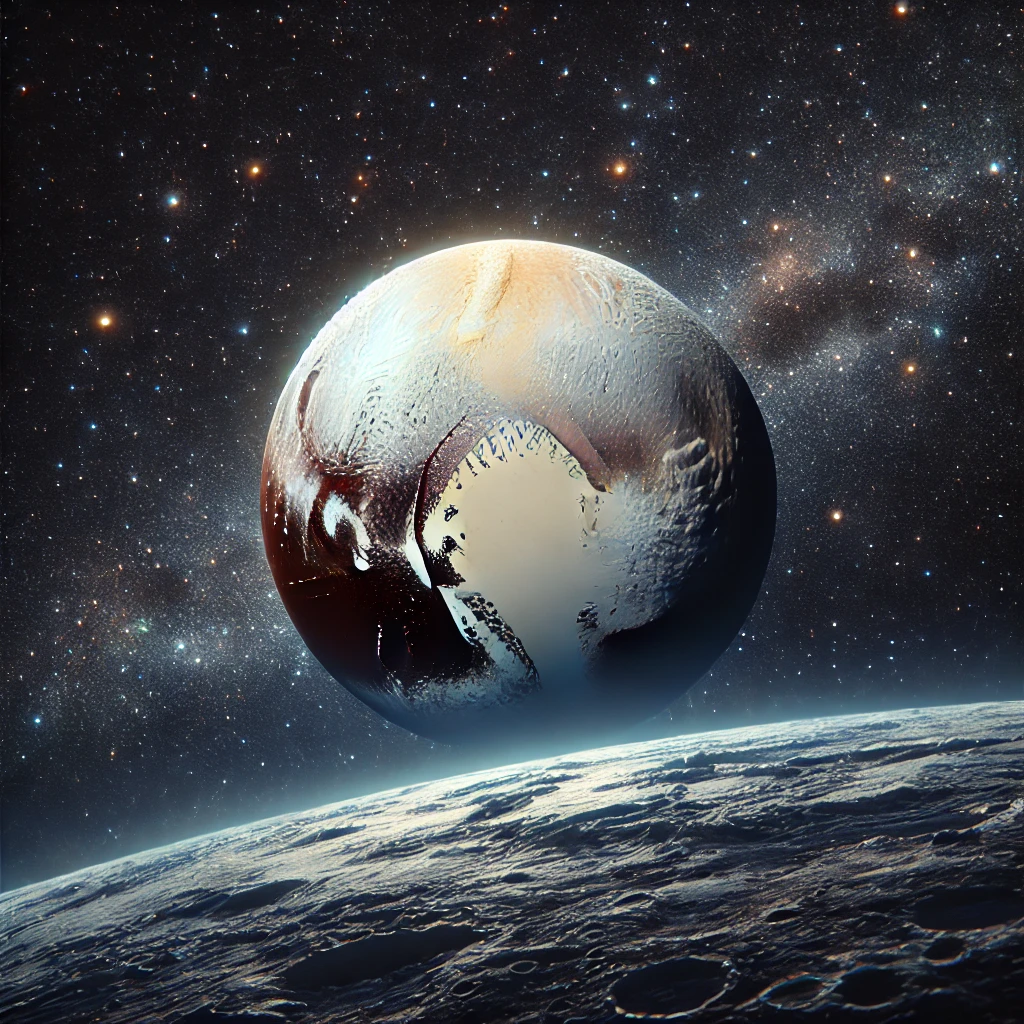Greetings, cosmic voyagers! Captain Nova here, back aboard the Odyssey Explorer for Day 13 of our “100 Days of Space Exploration.” Today, we’re venturing to a small but captivating world that has sparked debates, inspired imaginations, and redefined our understanding of the Solar System. Yes, I’m talking about Pluto, the dwarf planet that resides in the icy realms of the Kuiper Belt. So, buckle up and get ready to explore this enigmatic celestial body!

Pluto: Quick Facts
Let’s kick off with some fascinating facts about Pluto:
- Distance from the Sun: Approximately 5.9 billion kilometers (3.7 billion miles).
- Diameter: About 2,377 kilometers (1,477 miles), roughly two-thirds the size of Earth’s Moon.
- Day Length: 6.4 Earth days.
- Year Length: 248 Earth years.
- Surface Temperature: A frigid -229°C (-380°F).
- Moons: Five known moons, with Charon being the largest and most notable.
Pluto’s orbit is highly elliptical, sometimes bringing it closer to the Sun than Neptune. Its unique trajectory and characteristics make it one of the most intriguing objects in our Solar System.
A Journey of Discovery
Pluto was discovered in 1930 by American astronomer Clyde Tombaugh. For decades, it was celebrated as the ninth planet in the Solar System, but in 2006, its status was reclassified as a dwarf planet by the International Astronomical Union (IAU). This decision was based on new criteria for defining a planet, sparking widespread debate and a renewed interest in this distant world.
Surface and Composition
Pluto’s surface is a fascinating mosaic of icy plains, towering mountains, and deep craters. The most prominent feature is Sputnik Planitia, a vast, heart-shaped glacier composed primarily of nitrogen ice. This iconic region showcases Pluto’s dynamic geology, with evidence of flowing ice, possible cryovolcanism, and tectonic activity.
The planet’s surface is also rich in methane, carbon monoxide, and water ice. These elements interact with sunlight and cosmic rays, giving Pluto its reddish-brown hue.
Pluto’s Thin Atmosphere
Despite its small size and distance from the Sun, Pluto boasts a tenuous atmosphere composed mainly of nitrogen, with traces of methane and carbon monoxide. This atmosphere expands when Pluto is closer to the Sun and contracts as it moves farther away. Observations from the New Horizons mission revealed hazy layers extending up to 161 kilometers (100 miles) above the surface, creating breathtaking sunrises and sunsets.
Charon: Pluto’s Companion
Among Pluto’s five moons, Charon is the most remarkable. With a diameter of about 1,212 kilometers (753 miles), Charon is roughly half the size of Pluto, making it the largest moon relative to its parent body in the Solar System. The gravitational interaction between Pluto and Charon is so significant that they orbit a common center of gravity located outside Pluto’s surface, forming a binary system.
Charon’s surface features a striking red polar cap, likely caused by interactions between methane from Pluto’s atmosphere and solar radiation. Its deep canyons and fractured plains suggest a history of internal activity, hinting at the presence of a subsurface ocean in the past.
New Horizons: Unlocking Pluto’s Secrets
Our understanding of Pluto took a giant leap forward in 2015 when NASA’s New Horizons spacecraft conducted a historic flyby. This mission provided the first close-up images of Pluto, revealing its complex surface, diverse geology, and thin atmosphere. New Horizons also captured stunning views of Charon and Pluto’s other moons, providing invaluable data that continues to fuel scientific discoveries.
Key findings from New Horizons include:
- Evidence of active geological processes on Pluto’s surface.
- Detailed images of Sputnik Planitia and its surrounding terrain.
- Insights into the composition and behavior of Pluto’s atmosphere.
- Observations of Pluto’s smaller moons, such as Nix, Hydra, Kerberos, and Styx.
Pluto’s Role in the Kuiper Belt
Pluto is one of the largest known objects in the Kuiper Belt, a vast region of icy bodies beyond Neptune. This distant realm is home to countless comets, dwarf planets, and other celestial objects that hold clues about the early Solar System. Studying Pluto and its neighbors helps scientists unravel the mysteries of planetary formation and the evolution of our cosmic neighborhood.
A Planet or Not?
The debate over Pluto’s classification as a planet continues to spark discussions among scientists and the public. Regardless of its status, Pluto remains a symbol of exploration and discovery, reminding us of the ever-evolving nature of science and our quest to understand the universe.
The Allure of the Unknown
As I gaze at Pluto from the Odyssey Explorer, I’m reminded of its role as a frontier of human curiosity. This distant world, once shrouded in mystery, has become a window into the outer reaches of our Solar System. Its heart-shaped plains and icy landscapes remind us that even the coldest, most remote corners of the cosmos are filled with wonder.
Tomorrow, we’ll journey inward once more, exploring the fascinating region between Mars and Jupiter: the Asteroid Belt. Until then, keep your sense of adventure alive and your eyes on the stars.
Captain Nova
Odyssey Explorer
Leave a Reply